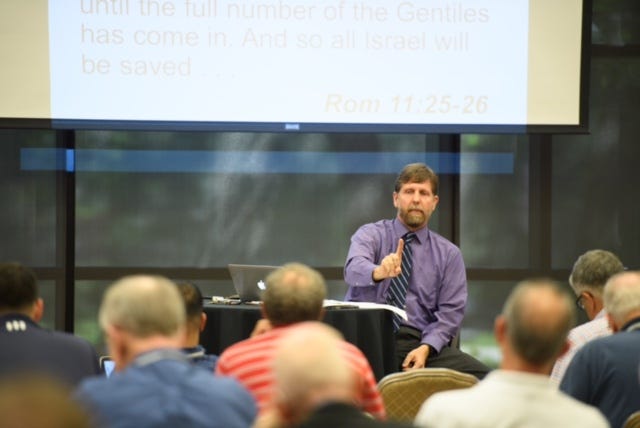The Gospel Project
Reading the Bible (& Seeing our Baptism) Through the Lens of the Gospel
In This Edition:
Fingers of Faith: Remembering the 7 Ones
A Conversation with Dr. Scott Adair
Top Picks: This Week’s Recommended Resources
Fingers of Faith: Remembering the 7 Ones
“Make every effort to keep the unity of the Spirit through the bond of peace. There is one body and one Spirit, just as you were called to one hope when you were called; one Lord, one faith, one baptism; one God and Father of all, who is over all and through all and in all.” (Ephesians 4:3-6 NIV)
Between 1827 and 1830, a preacher for the Mahoning Baptist Association by the name of Walter Scott developed a simple mnemonic device for children to remember the key elements involved in our response to gospel, as recorded in Acts 2:38. He taught the children to open their hand and count out a “five finger exercise”: (1) faith, (2) repentance, (3) baptism, (4) remission of sins, and (5) gift of the Holy Spirit. Through the years, churches connected to the American Restoration Movement adopted and adapted this device. Perhaps you remember learning it a bit differently: (1) hear, (2) believe, (3) repent, (4) confess, (5) be baptized.
The object of this simple children’s lesson was to create a “handy” way to summarize our response to the Christian story. But what if we could remind ourselves—young and old alike—of the story itself, the story to which we are called to respond?
Dr. Scott Adair has developed an equally simple mnemonic device to summarize the central truths of the Christian faith—found consistently in the early speeches of Acts, in the 7 ones of Ephesians 4, in the early creeds of the Christian church, and in orthodox Christianity throughout the ages. It’s also true that all 7 are proclaimed visibly in our faith response as we unite with Christ in baptism.
1. Thumbs Up: I Believe Jesus is Lord
Put your hand into a fist. Now raise your thumb. When you use the thumb emoji, you are saying “yes, I agree.” At our baptism, we ask “do you believe that Jesus Christ is the Son of God?” This is a non-negotiable, and we start our baptism with this proclamation. Jesus’ lordship. There is “one Lord” (Eph.4:5)
2. Index Finger: I Believe There is One God—Father, Son, & Spirit
Now put out your index finger and point it up. You will notice there are two lines on the inside of your knuckles, creating three sections. There is one God, manifest in three persons: Father, Son, and Spirit. We are baptized into the one (singular) name of the Father, Son, and Spirit (Matthew 28:19). Believing there is one God is clearly a non-negotiable central truth of the Christian faith, for everyone who comes to God must believe that He is (Hebrews 11). There is “one God” (Eph. 4:6).
3. Peace Sign: I Believe in the Death, Burial, and Resurrection of Jesus
Now hold out your first two fingers making the “peace” sign. With your other hand, run your finger down the inside of your index finger, and up the inside of your middle finger—symbolizing the death, burial, and resurrection of Jesus. Romans 6 clearly implies that our baptism shows our participation in the death, burial, and resurrection of Christ. Paul says in 1 Corinthians 15 this is of “first importance” as we put our faith in the finished work of Christ. There is “one faith” (Eph. 4:5).
4. Ring Finger: I Believe in One Body, the Church, the Bride of Christ
Now turn your attention to your ring finger. The ring symbolizes your relationship status. The church is married to Christ. Every believer, in their baptism, is added to the body of Christ, and becomes part of his bride. Paul says there is “one body” (Eph. 4:4), and this is one of the 7 core essentials of the Christian faith.
5. Pinky Finger: I (Weak and Sinful) Believe in the Forgiveness of Sins
Your pinky is your weakest and shortest finger, just as we are weak and “fall short” of the glory of God (Rom. 3:23). Our need for forgiveness is obvious. All people are called to repentance and baptism for the forgiveness of sins. We recognize that we bring nothing to God; God grants us righteousness because He alone has status (Rom 3:10, 21-26; Phil. 3:9; 1 John 2:1). Repentance acknowledges that we stand in need of God’s grace. Our “one baptism” (Eph. 4:5) is a passive act in which we allow someone to plunge us into Christ’s death, to receive the forgiveness He promises.
6. Palm Out: I Accept the Gift of the Holy Spirit
Place your palm out like you are receiving a gift. We also recognize that, in our baptism, we receive the gift of the Holy Spirit. There is “one Spirit” says Paul (Eph. 4:4), and having God’s spirit is proof that we are children of God (Gal. 4:6).
7. Raised Palm: I Believe in the Hope of Resurrection and Life Everlasting
Now, lift your palm raising it to the sky. Paul tells us there is “one hope” (Eph. 4:4), and that hope is the hope of resurrection and renewal. God will raise the dead and we shall be changed so that we may forever be with the Lord (1 Corinthians 15). God will also keep his promise to the whole creation, remove the curse of sin, and make everything right (Romans 8). We share this hope of resurrection and renewal.
For the fullest articulation of this proposal, see Scott’s chapter “Reading Scripture Baptismally” in the book Scripture First: Biblical Interpretation that Fosters Christian Unity (ACU Press, 2020), available here.
A Conversation with Dr. Scott Adair
Scott Adair is a professor of theology, scripture, and youth ministry at Harding University (Searcy, AR). For the past several years, he has been working on what he calls “the gospel project.” I sat down with Scott for episode 9 of the Avenue for Faith podcast.
Q: Scott, what is your project about?
There are some synonyms I would use here: what are the “non-negotiables”; what are the “essential tenets” of the Christian faith; what is the “core” of the faith. Another way is, simply, “what is the gospel?”, or, what is the proclamation that births the church in the first place? There is a proclamation that went first to the Jews and then to the Gentiles that brought about a united movement of Christ followers. And that actually happened before they had a Bible. So the proclamation that birthed the church actually precedes the New Testament. And what united those believers was the gospel. When you just ask the question, “what was that proclamation?”, we don’t have to grasp in the dark about what that proclamation was. Acts has like 20 different speeches. What was it that they were saying?
Q: How does this “central message” affect the whole?
We should read Scripture through the lens of the gospel. We should read Scripture knowing that the people who originally read Scripture had already had the Word of God, which was the gospel—that they had received, that had been given to them, had been preached to them, and they received and were included, and by that Word they were saved.
Q: You suggest that the central truths of the faith are seen in the practice of baptism. Explain that.
The Lord’s supper is a divine mnemonic device. The Lord himself reclaimed and renewed the passover bread and the passover cup and made it about himself. But he also gave us another divine mnemonic device—a way to encapsulate and remember. Even if you are not literate—you never read Scripture—you could know the gospel and remember the gospel through the Lord’s supper and through baptism. That the whole story is there in a nutshell—like, compressed—in the Lord’s supper and in baptism. And so we have got our two divine mnemonic devices to hold onto the central tenets of the Christian faith in the Lord’s supper and baptism. We know that the Lord’s supper has theological meaning. We’ve been very careful to unpack the truths proclaimed about Christ in the Lord’s supper. But we’ve not always been good about unpacking the proclamation that baptism makes. So it’s not just about when one is saved; it tells us about the One who saves. There is actually a whole lot we are saying about who God is and what he has done for us in baptism. The gospel is so laden in the ceremony.
Q: Scott, how does your project aim toward a deep unity?
I’m not really interested in trying to push or nudge people to the right to be a little bit more conservative on these brotherhood matters. I’m also not interested in nudging people a little bit more to the left and be a little more open minded on this or that brotherhood issue. And I’m actually not even interested in trying to draw both to some sort of middle ground moderation. I think that is a moving target itself. But what I’m interested in is getting everybody on the right, the left, the center, to not make it about these secondary issues but for all of us to move down deeper and to find our identity, our purpose, our proclamation in the gospel. We don’t need to be sliding along the continuum of right/left. We need to be—all of us—moving deeper into the gospel, the non-negotiable tenets of Christian faith.
Excerpts from Episode 9 of the Avenue for Faith podcast, titled “The Gospel Project.” Available on all podcast platforms.
Top Picks: This Week’s Recommended Resources
Three Interesting & Helpful Christian Web Journals & Magazines
Christian Studies Journal (1980-2019). Ministry meets theological reflection.
Themelios. Evangelical theological journal, hosted by the Gospel Coalition.
Touchstone Magazine. Celebrating the ‘Great Tradition’ of historic Christian faith.
Three Interesting & Helpful Podcasts
Help Me Teach the Bible (w/Nancy Guthrie). Talks with teachers and preachers on creatively teaching through books of the Bible.
Ask NT Wright Anything (w/N. T. Wright). Tom Wright answers your questions.
Timothy Keller’s Sermons Podcast (w/Tim Keller). Powerful and informative lessons.
Three Interesting & Helpful Personal Blogs & Websites
Faith and Theology. The online blog of Ben Meyer.
Ifaq theology. Ron Highfield’s theology blog.
Jim Martin’s Encouragement Note & God-Hungry blog site.
Subscribe to Avenue For Faith
Avenue For Faith is a publication of the Adult Education Ministry of Sherrod Avenue Church of Christ in Florence, Alabama. My name is Nathan Guy, and I am the Minister of Adult Education. I am happily married to Katie and also serve as President of Mars Hill Bible School. You can find more resources on our website over at avenueforfaith.org. Follow us @avenueforfaith (fb/tw/ig).









